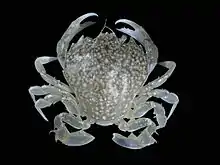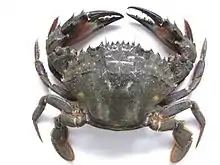Portunoidea
Portunoidea is a superfamily of crabs that includes the family Portunidae, the swimming crabs. Which other crab families are also placed here is a matter of some contention, and may be revised following molecular phylogenetic analyses.[1]
| Portunoidea | |
|---|---|
 | |
| Portumnus latipes of the Portunidae | |
| Scientific classification | |
| Kingdom: | |
| Phylum: | |
| Subphylum: | |
| Class: | |
| Order: | |
| Infraorder: | |
| Section: | |
| Subsection: | |
| Superfamily: | Portunoidea Rafinesque, 1815 |
| Families [1] | |
|
7 extant and 4 extinct families: see text | |
Description
Their rather flat and smooth carapace is usually wider than long and of hexagonal, subhexagonal, rectangular, or transversely ovate shape. It is usually widest between the hindmost spines of the forward rim; there may be up to 9 pairs of these spines, with a few smaller ones right above the head, but they are missing altogether in some species.[2]
In some, the first maxilliped's endopod is lobed, forming the characteristic portunid lobe. The chelipeds are usually robust, and in some the last pereiopod pair has ovate dactyls. The sutures of the sternum between segments 4 to 8 are usually incomplete, and in the Portunidae, the eighth sternite is usually visible if seen from below and has a penial groove.[2]
In males, the abdominal somites are either all free or the third to fifth are fused, often retaining the sutures though. The first gonopod is strongly curved, with a swollen and strongly hooked base.[2]
Classification
Portunoidea are close relatives of the Xanthoidea,[2] and the families Hexapodidae and Mathildellidae, usually included there, are sometimes placed in the Portunoidea, while the deep-sea crabs (Geryonidae) are usually placed in the Portunoidea but sometimes in the Xanthoidea. All Portunoidea live in the ocean, although the family Trichodactylidae, sometimes included here, live in fresh water.
According to the latest synopsis, there are eleven families in the superfamily Portunoidea, four of which are extinct:[1]
- Carcinidae
- Carcineretidae (extinct)
- Catoptridae
- Geryonidae
- Lithophylacidae (extinct)
- Longusorbiidae (extinct)
- Macropipidae
- Pirimelidae
- Portunidae
- Psammocarcinidae (extinct)
- Thiidae
References
| Wikimedia Commons has media related to Portunoidea. |
- Sammy De Grave; N. Dean Pentcheff; Shane T. Ahyong; et al. (2009). "A classification of living and fossil genera of decapod crustaceans" (PDF). Raffles Bulletin of Zoology. Suppl. 21: 1–109.
- Hiroaki Karasawa & Carrie E. Schweitzer (2006). "A new classification of the Xanthoidea sensu lato (Crustacea: Decapoda: Brachyura) based on phylogenetic analysis and traditional systematics and evaluation of all fossil Xanthoidea sensu lato". Contributions to Zoology. 75 (1/2): 23–73. Archived from the original on 2016-03-03. Retrieved 2008-11-23.
